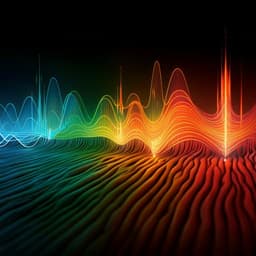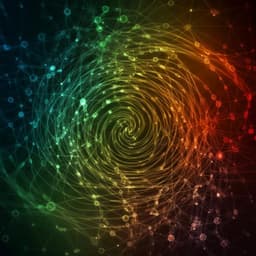
Medicine and Health
In vivo imaging in mouse spinal cord reveals that microglia prevent degeneration of injured axons
W. Wu, Y. He, et al.
This groundbreaking research by Wanjie Wu, Yingzhu He, Yujun Chen, Yiming Fu, Sicong He, Kai Liu, and Jianan Y. Qu uses in vivo imaging to showcase how microglia, the central nervous system's immune soldiers, offer crucial protection to injured axons. Discover how these tiny warriors wrap around myelinated axons at Nodes of Ranvier to prevent degeneration following injury!
~3 min • Beginner • English
Introduction
Spinal cord injury (SCI) causes profound functional deficits and lacks curative treatments. Progress in understanding axon damage and regeneration in vivo has been limited by imaging approaches that perturb the spinal microenvironment. Microglia are CNS-resident immune cells that survey tissue and rapidly respond to injury, forming direct contacts with neuronal compartments that can modulate neurogenesis, synaptic plasticity, firing, degeneration, and regeneration. The Nodes of Ranvier (NR) are specialized unmyelinated domains of myelinated axons and have emerged as preferential sites for microglia-axon communication. Prior work showed microglial processes converge at NR and that NRs are early disruption and sprouting sites after spinal injury. The central hypothesis is that NRs act as hubs regulating axonal function and fate via direct, activity-modulated microglial contacts, especially during acute axonal injury. This study uses minimally invasive in vivo imaging and precise laser axotomy to define the dynamics, mechanisms, and functional consequences of microglia-NR interactions in the mouse spinal cord.
Literature Review
Prior studies documented diverse microglia-neuron contacts beyond synapses, including somatic junctions that protect neuronal function. Microglial contacts with axons and at NRs have been observed across species and proposed to aid remyelination after demyelinating insults. In SCI models, axons exhibit acute bidirectional degeneration proximal and distal to lesions, followed by Wallerian degeneration distally. Conventional SCI models (transection, crush, contusion) complicate mechanistic dissection due to complex lesion microenvironments. Two-photon guided laser axotomy enables precise single-axon injury. Earlier work revealed microglial convergence to nodes after injury and identified NRs as initial disruption and sprouting sites. Purinergic signaling via microglial P2Y12 receptors mediates microglial process recruitment to hyperactive or injured neuronal elements. ATP release from axons via volume-activated anion channels (VAAC) during swelling and activity can attract microglia. Ion channels (NaV, K+ channels including K2P) at nodes shape excitability and may influence microglia-node communication.
Methodology
- Animals: Adult CX3CR1+/GFP mice and Thy1-YFP × CX3CR1GFP/+ mice (10–20 weeks, both sexes) under approved HKUST protocols. Microglia labeled with EGFP, axons with YFP.
- Surgical preparation: Optically cleared intervertebral window with intact ligamentum flavum over T12–T13 to minimize immune activation. Iodixanol used for optical clearing; Texas Red-dextran injected for vasculature when needed.
- In vivo imaging: Integrated stimulated Raman scattering (SRS) and two-photon excited fluorescence (TPEF) microscopy. SRS (pump 796 nm, Stokes 1031 nm) at 2863.5 cm−1 for myelin; TPEF (920 nm) for YFP/GFP/ATP sensor/Texas Red. Time-lapse imaging with 5–10 min intervals. Image registration and analysis performed in Fiji/MATLAB using established pipelines.
- Identification of Nodes of Ranvier: NRs identified by YFP-thinning and absence of SRS myelin signal; validated by Caspr immunostaining at paranodes (>92% correspondence).
- Laser axotomy: Localized femtosecond laser (920 nm, 200–300 mW, 1–4 s) guided by TPEF to produce single-axon lesions at defined distances (typically 50–300 μm) from target NRs or branch points; imaging from 0.5 h pre- to post-injury and follow-ups to 48 h.
- Microglia depletion: PLX3397 chow (290 mg/kg) for 3 weeks; microglial density quantified in 300×300×45 μm volumes.
- Pharmacology (intrathecal, 10 μL): P2Y12 antagonist PSB0739 (0.1 mg/mL), VAAC blocker NPPB (1.5 mg/mL in 10% DMSO/40% PEG300/5% Tween-80/45% saline), NaV blocker tetrodotoxin (TTX, 0.5 μg/kg), K+ channel blockers TEA (1 mg/mL) and K2P inhibitor TPA-Cl (1.5 mg/mL), non-hydrolyzable ATP analog AMPPNP (15 mg/mL). Vehicle controls included saline and solvent controls as appropriate. Imaging within defined efficacy windows (e.g., within 6 h for PSB).
- Neuronal activity manipulation: Electrical stimulation via bipolar needles in hind limb foot pad (0.28 mA, 10 min) during imaging to elevate activity.
- ATP sensing: AAV2/9-hsyn-cATP1.0 (GRABATP) injected into spinal cord (0.4 mm lateral, 0.2 mm depth; 500 nL per site) to monitor extracellular ATP dynamics after laser injury and pharmacology.
- Quantifications: Microglia-node contact classified as intermittent (secondary processes) vs continuous (soma/primary processes). Wrapping contact defined as convergent, robust ensheathment at NR/paranode after injury. Outcomes: contact frequency/duration, fraction of nodes contacted over time, time to wrapping, persistence of wrapping, axonal degeneration distance relative to NR/BP at 0–48 h post-injury. Statistical tests as indicated (e.g., Friedman with Dunn’s multiple comparisons).
Key Findings
- Physiological microglia-NR interactions:
- Time-lapse in vivo imaging (3 h, 5-min intervals) of 67 NRs (7 mice) showed dynamic microglial contacts with NRs; 49/67 exhibited intermittent, random scanning contacts; 18/67 had continuous contacts.
- Intermittent contacts were predominantly via secondary processes (48/49), whereas continuous contacts were mostly initiated by soma/primary processes (15/18).
- Across time, 55–70% of NRs were contacted at any given time; all NRs were contacted at least once within 3 h.
- Internodes showed significantly lower contact rates than nodes (supporting NR as surveillance hotspots).
- Injury-evoked wrapping contact is localized and rapid:
- Laser axotomy (50–300 μm from NR) triggered robust microglial wrapping at the nearest nodes in 25/26 cases within 1 h post-injury (hpi); second-closest nodes showed intermittent/physiological-like contacts.
- Wrapping arose at both proximal and distal nodes when injury occurred between two nodes, even when distal segments were disconnected from soma (5/5 cases wrapped at both nearest proximal and distal nodes).
- Wrapping persisted hours but declined: 7.7% lost wrapping by 2 hpi; 15.4% by 4 hpi; by 24 hpi, only 1/13 wrapping contacts remained, often reverting to transient contacts.
- Protective effect on acute axonal degeneration:
- In controls, injured axons typically ceased acute retrograde degeneration slightly before/at the wrapped NR by 4 hpi, independent of axotomy-NR distance; 22/25 axons stopped before the NR by 4 hpi; most remained proximal to the NR at 24–48 hpi (18/22 stable by 24 hpi).
- At secondary branch points (BPs), injury to one daughter branch led to microglial wrapping and degeneration stopping before the BP by day 2 in all tested axons (n=4). With sequential injury of both branches, microglia wrapped only one branch in most (5/6) and degeneration commonly breached the BP within 1 day (5/6).
- Microglia depletion removes protection:
- PLX3397 depleted ~82% microglia and eliminated microglia-node contacts at selected nodes. Without microglia, 75% (9/12) of axons degenerated beyond NRs within 4 h post-axotomy; 1/12 further breached nodes by 24 h.
- At secondary BPs, single-branch injury did not breach BPs (6/6), likely due to intact contralateral branch; double-branch injury breached BPs at high rate (5/6), similar to controls.
- P2Y12-dependent signaling is required for wrapping:
- P2Y12 antagonist PSB0739 (intrathecal) did not alter physiological microglia-NR contact time or percentage of contacted NRs but nearly abolished injury-evoked wrapping: only 2/21 nodes showed transient wrapping and these did not prevent nodal breach; without wrapping, 90% (9/10) axons degenerated past nodes within acute phase, resembling microglia depletion.
- ATP release via VAAC contributes to wrapping signal:
- VAAC blocker NPPB significantly reduced microglial chemotaxis to laser injury and decreased ATP sensor response; after NPPB, 88.9% (8/9) injured axons were not wrapped and degenerated out of nodes within 3 h.
- PSB did not reduce ATP sensor responses, indicating it acts downstream of ATP at microglia; NPPB likely reduces axonal ATP release upstream.
- Ion channels modulate interactions and outcomes:
- Electrical stimulation increased the fraction of NRs contacted by microglia in vivo (mean ~57% pre vs ~66% post), indicating activity dependence, but did not trigger wrapping in physiological conditions.
- NaV blocker TTX: did not affect physiological contact metrics but reduced injury-evoked wrapping (wrapping absent in 56.25%, 9/16). Notably, even without wrapping, 62.5% (5/8) of axons stopped degeneration before nodes over 2 days—significantly better than PSB/NPPB/PLX conditions—implicating NaV activity in degeneration propagation.
- K+ channels: TEA (Ca2+-activated/voltage-gated K+ blocker) had minimal effects on physiological contacts and wrapping in spinal cord; K2P inhibitor TPA-Cl significantly reduced wrapping after injury, implicating K2P channels in microglia-node interactions.
- Overall, microglial wrapping at NRs acts as a localized, acute barrier limiting retrograde axonal degeneration, requiring microglial P2Y12 signaling likely driven by axonal ATP release via VAAC, and modulated by NaV and K2P channel activity.
Discussion
The study answers whether and how microglia at Nodes of Ranvier protect injured axons in vivo. Under physiological conditions, microglial processes continuously and intermittently survey NRs, maintaining a stable fraction of contacted nodes, consistent with activity-dependent surveillance. Upon precise single-axon injury, microglia transform their nodal contacts into a rapid, localized wrapping that confines acute retrograde degeneration to before/at the wrapped NR. Eliminating microglia or blocking their P2Y12 receptors abolishes wrapping and allows degeneration to proceed beyond nodes, establishing causality for a microglia-mediated protective barrier. Pharmacological evidence supports a mechanism where axonal ATP release via VAAC upon swelling or activity engages microglial P2Y12 to trigger wrapping. Ion channel manipulations refine this picture: TTX reduces wrapping yet paradoxically limits degeneration even without wrapping, consistent with NaV-dependent calcium influx and protease activation driving dieback; K2P channels facilitate wrapping after injury, while TEA-sensitive K+ channels play little role in the spinal context. At branch points, an intact branch predominantly stabilizes the structure after injury, with microglial wrapping contributing less to fate determination when both branches are damaged. These findings highlight a specialized, neuroprotective neuron–microglia physical interaction at nodal domains that shapes the acute course of axonal degeneration and may inform strategies to preserve axonal integrity after CNS injury.
Conclusion
This work establishes that microglia engage in activity-modulated, intermittent surveillance of Nodes of Ranvier in the intact spinal cord and rapidly convert to a robust, localized wrapping at nodes after axonal injury. This wrapping, dependent on microglial P2Y12 signaling and likely triggered by axonal ATP release via VAAC, acts as a barrier that halts acute retrograde degeneration at or before nodes. Depletion of microglia or inhibition of P2Y12/VAAC abolishes wrapping and permits nodal breach, whereas NaV blockade can curtail degeneration even without wrapping. K2P channels contribute to wrapping, whereas TEA-sensitive K+ channels have minimal influence in this model. The findings reveal a discrete, neuroprotective microglia–axon mechanism at nodal domains and suggest therapeutic avenues targeting purinergic signaling and ion channel function to limit axonal dieback after injury. Future work should dissect the downstream effectors of wrapping (e.g., modulation of calcium influx, mitochondrial function), determine persistence and roles of specialized contacts in subacute/chronic phases and regeneration, and validate these mechanisms in clinically relevant, large-scale SCI models.
Limitations
- Injury model generalizability: The laser axotomy model affords precise, minimally invasive perturbation but does not replicate the complex microenvironment of large-scale SCI (transection, compression, contusion). Findings should be cautiously extrapolated.
- Pharmacological specificity: NPPB, a VAAC blocker, also suppresses microglial ATP-mediated chemotaxis, complicating attribution solely to axonal ATP release pathways. Results with NPPB are not definitive.
- ATP imaging sensitivity: Attempts to directly visualize ATP release at NRs with a GRABATP sensor were limited by sensor expression/sensitivity in myelinated axons, precluding direct confirmation of nodal ATP release.
- Anesthesia and activity: Long-term anesthesia may dampen neuronal activity, potentially masking TTX effects on physiological contacts; the proportion of YFP-labeled neurons activated by electrical stimulation is undetermined.
- Field of view and sampling: Imaging typically encompassed one to two adjacent nodes, which may miss more distant effects; wrapping is transient and may be under-sampled at later time points.
- Microglia depletion was partial (~82%) and nodes far from residual microglia were selected; complete systemic absence of microglia was not achieved.
Related Publications
Explore these studies to deepen your understanding of the subject.







